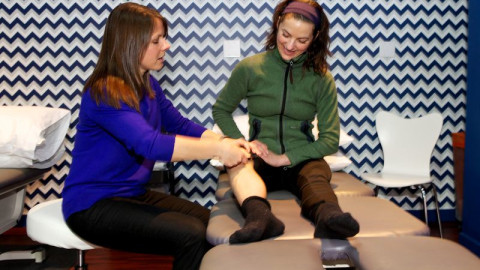Gymnastics and Lower Back Pain: My Experience
I was 11 years old when I first started having pain in my lower back during gymnastics. I was a level 8 gymnast training 4 hours/day, 6 days/week…not unusual for gymnasts. It wasn’t until the pain was so bad that I could no longer perform any skills that involved arching (hyperextending) my back that I finally told my coaches that my back hurt. From that point forward, my gymnastics career was plagued by lower back pain. I went to physical therapy off and on but never changed my training habits. I also could not find a physical therapist who understood the unique physical and mental requirements for doing women’s artistic gymnastics so I had little guidance on modifying and progressing back to my sport. On top of that, during my junior year of high school as a level 10, I fractured a vertebra in my back during a bad fall on floor, just before the start of the gymnastics season.
Forced to finally rest and modify my training, I recovered somewhat and made it to my senior year competition season, but there was still pain. With force of will and some extremely lucky circumstances, I managed to earn a spot on the San Jose State University gymnastics team, where I continued to train and compete through my pain. It was not until I retired from gymnastics after college that I took the time to learn what was really wrong with my back. I was diagnosed with a spondylolisthesis in my lumbar spine. This is an anatomical change that has occurred in my body, and it requires me to perform core stability exercises daily in order to prevent pain flare ups. After years of physical therapy study and treatment during my post-gymnastics life, I now have much better control over my condition and am able to stay active with running, cycling, Pilates and of course, my physical therapy exercises.
Most Common Back Injuries in Female Gymnasts
Spondylolisthesis – an anterior shift of a spinal vertebra/bone; 1 vertebra in the spine slips forward on the vertebra below it. This occurs from repetitive hyperextension over a long period of time, coupled with core weakness. A spondylolisthesis creates instability in the spine, strain on the surrounding nerves and musculature, and pain.
Spondylolysis – AKA Pars Defect, is a stress fracture of part of the vertebra. This also occurs with repetitive hyperextension and when spondylolisthesis goes untreated. A spondylolysis creates pain and potential damage to the spinal cord and surrounding nerves.
What Can I Expect in Physical Therapy?
• Exercises to strengthen the core stabilizers: the transversus abdominis, multifidi, glutes, and the pelvic floor.
• Movement retraining and neuromuscular re-education to correct compensatory movement patterns.
• Guidance on how to modify your gymnastics training and conditioning to best facilitate a speedy, long-term recovery.
• Sports-specific exercises to progress you back to all of your skills. The physical therapists at Therapydia are well-versed in the sport of gymnastics and have years of experience working with these athletes to meet their unique needs.
• Communication between PT, the athlete, the coaches, and the parents throughout your care.
Don’t Make the Same Mistakes I Did as a Young Gymnast
• Do not be afraid to let your coaches/parents know when something hurts. They want you to be healthy, to have fun, and to thrive in your sport! If you feel a new ache or pain, let them know.
• Parents and coaches, remember to remind your athletes that you WANT to know when they are hurting so that you can help. Stay solution-oriented when they come to you.
• Visit your physical therapist at the first signs of pain; do not wait. It is often much easier and faster to resolve a new problem early on rather than after pain has become severe and compensations have set in.
• Do not settle for functional but painful (AKA training/competing through pain); fully commit to your recovery in order to break the cycle of being injured over and over again.
• Remember that there are no quick-fixes. Lower back pain usually occurs in young athletes after months or even years of poor movement patterns and habits. It will take time and consistency to create permanent change.
• Think long-term. It is not about just getting through this season. If your goal is to continue participating in gymnastics for years to come, you have to take care of your most important tool (your body) NOW.
• Remember, you are basically a back-flipping ninja. So have fun!
By Shanice Lowe, PT, DPT
Therapydia Saratoga Physical Therapist









